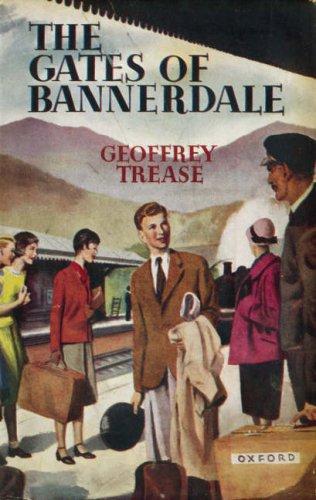It's rather a strange story, really. In 1933 a young man called Geoffrey Trease came across a book called Moscow has a Plan, in which (as wikipedia helpfully informs us):
a Soviet author dramatised the first Five-year plan for young readersDespite his bourgeois origins, Trease had rejected the class-based teaching he'd encountered during his first year of a Classics degree at Oxford, and had moved to London determined to find some other way of becoming a writer.
Now, inspired by the Russian book, he wrote a 'revisionist' children's book about Robin Hood entitled Bows against the Barons (1934), which not only included a left-wing political agenda, but also an unusual - for the time - emphasis on strong characters, both female and male, from a variety of social backgrounds, and an insistence on using contemporary rather than Wardour-Street ("Tush, varlet ... Gadzooks", etc.) English.
His specifically communist leanings may have faded over time (the great Stalinist purges of the 1930s were a bit of a disincentive to fellow travellers everywhere), but Geoffrey Trease remained throughout his career a strong proponent of progressive values - in distinct contrast to most of his predecessors (and many of his contemporaries) in children's writing.
Not that he was only a children's writer - or only a writer of historical fiction, for that matter. That was the field in which he achieved greatest distinction, but he also wrote adult novels, non-fiction (including three volumes of memoirs), and even literary criticism.
For more on all these subjects, I recommend his autobiography, the first two volumes of which I bought from a library throwing-out table a few years ago:
- A Whiff of Burnt Boats: An Early Autobiography. St. Martin’s Press. London: Macmillan & Co., 1971.
- Laughter at the Door: A Continued Autobiography. London: Macmillan London Ltd., 1974.
- No Boats on Bannermere. Illustrated by Richard Kennedy. Bannerdale series, 1. 1949. London: Heinemann, 1963.
- Under Black Banner. Illustrated by Richard Kennedy. Bannerdale series, 2. London: William Heinemann Ltd., 1951.
- Black Banner Players. Illustrated by Richard Kennedy. Bannerdale series, 3. 1952. Coleford, Radstock, Somerset: Girls Gone By Publishers, 2005.
- Black Banner Abroad. Bannerdale series, 4. 1954. The New Windmill Series. Ed. Anne & Ian Serraillier. London: Heinemann, 1962.
- The Gates of Bannerdale. Bannerdale series, 5. 1956. London: William Heinemann Ltd., 1965.
As a group, I suppose they were inspired mainly by Trease's own residence in the Lake District from the 1940s on. One can't, however, avoid the suspicion that they were also designed as a kind of antidote to an even more famous series of books, Arthur Ransome's 12 Swallows and Amazons books, set on an unnamed lake a little like Windermere, though with features borrowed from various other lakes nearby.
- Swallows and Amazons (1930)
- Swallowdale (1931)
- Peter Duck (1932)
- Winter Holiday (1933)
- Coot Club (1934)
- Pigeon Post (1936)
- We Didn't Mean to Go to Sea (1937)
- Secret Water (1939)
- The Big Six (1940)
- Missee Lee (1941)
- The Picts And The Martyrs: or Not Welcome At All (1943)
- Great Northern? (1947)
Ransome was by no means a reactionary. He had in fact been suspected of espionage for the Soviets at the time of the Revolution in 1917, and was close to Lenin and Trotsky at that time (he ended up marrying the latter's secretary, Evgenia Petrovna Shelepina). He made a valiant attempt to portray some working class characters in Coot Club and its various sequels, but for the most part his children do live in a kind of fairyland of complete behavioural licence and freedom from economic pressure.
When the children decide to go off and camp on an island in the middle of the lake in the first of the books, for instance, their father's telegram of permission famously reads: "BETTER DROWNED THAN DUFFERS IF NOT DUFFERS WON'T DROWN."
For Trease, they appear to have acted a little like R. M. Ballantyne's Coral Island did for William Golding's Lord of the Flies. The delightful (or irritating, depending on your point of view) lack of reality in the Swallows and Amazons books may have spurred him into wondering what it would be like if some child characters really did have to deal with modern life in a more-or-less unadorned form?
Which is not to say that No Boats on Bannermere (1949) is not an exciting adventure story. Published almost twenty years after the first of Ransome's Lake District romances, it also deals with a mysterious island, boating adventures, and a host of picturesque characters. The difference is that the children's mother is divorced, has to make money doing 'teas' for visitors, and that a basic pragmatism and verisimilitude underlies all their doings.
Trease has also learned that readers can be interested just as easily by the everyday details of life in a North Country cottage as by buried treasure or ancient skeletons. But he doesn't really stint on either. Seventy years after it was published, No Boats on Bannermere now gives an agreeably distant feeling of post-war Britain, complete with rationing, housing restrictions, and other - now fascinating - details of life in that era.
Its sequels go on to flesh out the picture with subjects such as the need to reclaim confiscated - but no longer needed - land from the War Office, the complex politics of local drama groups, the challenges of going abroad on limited funds, and - finally - the realities of life as a first year undergraduate.
In each case one feels that not only does Geoffrey Trease know exactly what he's talking about, but that the mechanics of such everyday dilemmas are, finally, far more interesting than - say - the fantasy worlds of Ransome's Peter Duck or Missee Lee. A rattling good yarn can far more readily be written, he appears to imply, from the day-to-day details of one's own suburb or village than from some half-baked otherwhere.
I liked all of the books, but the last one, The Gates of Bannerdale, where Bill Melbury finally leaves his tiny village to go to Oxford, was definitely my favourite. Heightened, packed with incident, certainly - but basically plausible: that was the hallmark of all of Geoffrey Trease's books.
Funnily enough, my father only owned four of the five novels in the series, so the third, Black Banner Players, remained a mystery to us. There were enough references to it in the remaining two books to deduce what it was about, but I didn't read it until I myself went off to university in the UK.
In my first year at Edinburgh university, I'd got into the habit of ordering up piles of books from the stacks from my desk in the National Library of Scotland. One day it occurred to me that, given it was one of Britain's major copyright libraries, they might well have a copy of Black Banner Players. As it turned out, they did, and so that's where I first encountered it.
I didn't like it. The conditions were not particularly conducive to relaxed reading: and it seemed to me to contain too much of a concentration on one of Trease's obsessions: shoplifting (which recurs in his later Maythorn series). That would be a good thirty years ago now, and I've recently re-read the book with very different feelings. It now seems to me every bit as good as the others, and in fact a very satisfactory addition to the series.
It's still by far the most difficult of the books to find second-hand, so I was forced to buy a paperback reprint by a firm called "Girls Gone By," specialising in forgotten children's books. Even that wasn't cheap. So if you ever see a hardback copy in good condition lying around, I'd suggest getting down on it pretty quickly.
And, if you haven't read any of them, you might well feel like giving Geoffrey Trease's books a go. The innovations he pioneered are now pretty universally accepted, so they're unlikely to strike you as particularly modern or revisionist - but the man hailed by George Orwell as "that creature we have long been needing, a ‘light’ Left-wing writer, rebellious but human" is unlikely ever to fade into complete obscurity.
Here's a list of the unfortunately very limited number of books by him I own. They do include some interesting curiosities, though. As well as his two 'Maythorn' books, I also have the pair he wrote about Garibaldi, as well as his novels about Greek drama - The Hills of Varna and The Crown of Violet:
- Cue for Treason. 1940. Illustrated by Zena Flax. Puffin Books. 1965. Harmondsworth: Penguin, 1971.
- The Hills of Varna. Illustrated by Treyer Evans. 1948. London: Macmillan & Co Ltd., 1956.
- The Crown of Violet. 1952. Illustrated by C. Walter Hodges. Puffin Books. Harmondsworth: Penguin, 1968.
- The Maythorn Story. Illustrated by Robert Hodgson. London: William Heinemann Ltd., 1960.
- Change at Maythorn. Illustrated by Robert Hodgson. 1962. London: The Children’s Book Club, 1963.
- Follow My Black Plume. 1963. Illustrated by Brian Wildsmith. Puffin Books. Harmondsworth: Penguin, 1972.
- A Thousand for Sicily. Illustrated by Brian Wildsmith. London: Macmillan & Co. Ltd., 1964.
- The Red Towers of Granada. 1966. Illustrated by Charles Keeping. Puffin Books. Harmondsworth: Penguin, 1972.















































